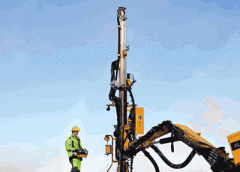MSHA’s Accident Prevention Program includes tips on drilling and blasting safety. Following are several items the agency wants to bring to the attention of plant operators or contractors performing drilling and blasting operations in quarries.
Avoid Surface Entanglements
Many accidents have occurred when miners have come into contact with rotating drills: They tried to manually thread drill steels, unplug clogged suction hoses, or just got too close to the rotating steels when the accident occurred. Whatever the reason, these accidents can be avoided if you follow these best practices.
- Train personnel to follow the manufacturer’s procedures when adding drill steels.
- Never manually thread drill steels when the drill head is rotating.
- Do not wear loose fitting clothing when working around drills. Also be careful of long hair that can become entangled.
- Never over-ride or bypass the safety features on the equipment.
- Know where your emergency stop switches are and ensure they are functional.
- Provide safe routing of hoses and cables so they are not close to the rotation of the drill.
- Shut down the drill when making any repairs to the drill head.
- Make the drill operator aware of your presence when approaching.
- Provide adequate lighting at night when drilling.
Bulk Truck Maintenance
A blaster from Indiana reminded drilling and blasting professionals to clean the auger of bulk explosive trucks on a weekly basis. He related the following situation to MSHA and encouraged it be shared with other explosive handlers.
While using a bulk truck to load Ammonium Nitrate and Fuel Oil (ANFO) on a cool morning, this blaster noticed smoke rising from the end of the auger. He immediately ceased loading and closely examined the auger. What he noticed caused concern to the blaster.
The smoke was actually the result of a buildup of a sensitized explosive blend that had become heated within the auger assembly. The truck had been previously used to blend ANFO with an emulsion product. Improper cleaning of the auger assembly allowed the blend to build up within the auger, causing constriction within the assembly. The friction, caused from the rotating action of the auger, created heat causing the explosive to steam and/or smoke.
A weekly examination and cleaning of the auger assembly on bulk trucks allows for easier transport of the explosive throughout the auger assembly. The easier material is transported throughout the auger, the less heat and pressure that is produced. In addition, a clean auger allows for a complete blending of the ANFO and emulsion components, improving detonation characteristics.
This procedure takes very little time. Anyone familiar with explosives knows that they can detonate from excessive heat and pressure. At the times explosives are safe and stable, precautions need to be taken to protect this product from extraneous sources of heat and pressure.
Driller-Blaster Communication
Since 1978, 281 incidents have occurred where individuals were struck by material being blasted at mine sites. In order for a blaster to safely determine the amount of explosive to be loaded in boreholes, the condition of the material being blasted needs to be determined.
The best person to provide this information is the driller. An experienced driller can determine many things about the rock being drilled from the way the drill operates. The driller is the only individual who knows this information.
Voids, mud seams and cracks are prime examples of rock irregularities that a driller needs to know about. Often times these irregularities occur in only a small portion of the rock to be blasted. Many of these irregularities are not known and taken into account by the blaster. Serious flyrock may occur.
This is why drill logs are important to the blaster.
- The drill log should document any and all conditions concerning the rock being drilled. Furthermore, this log should be provided to the blaster prior to loading any explosives into boreholes.
- Logging blast-holes is an important part of a successful blasting operation.
- Drillers need to provide this information to blasters. Blasters need to use this information.
Communication costs nothing, takes little time and saves lives.

